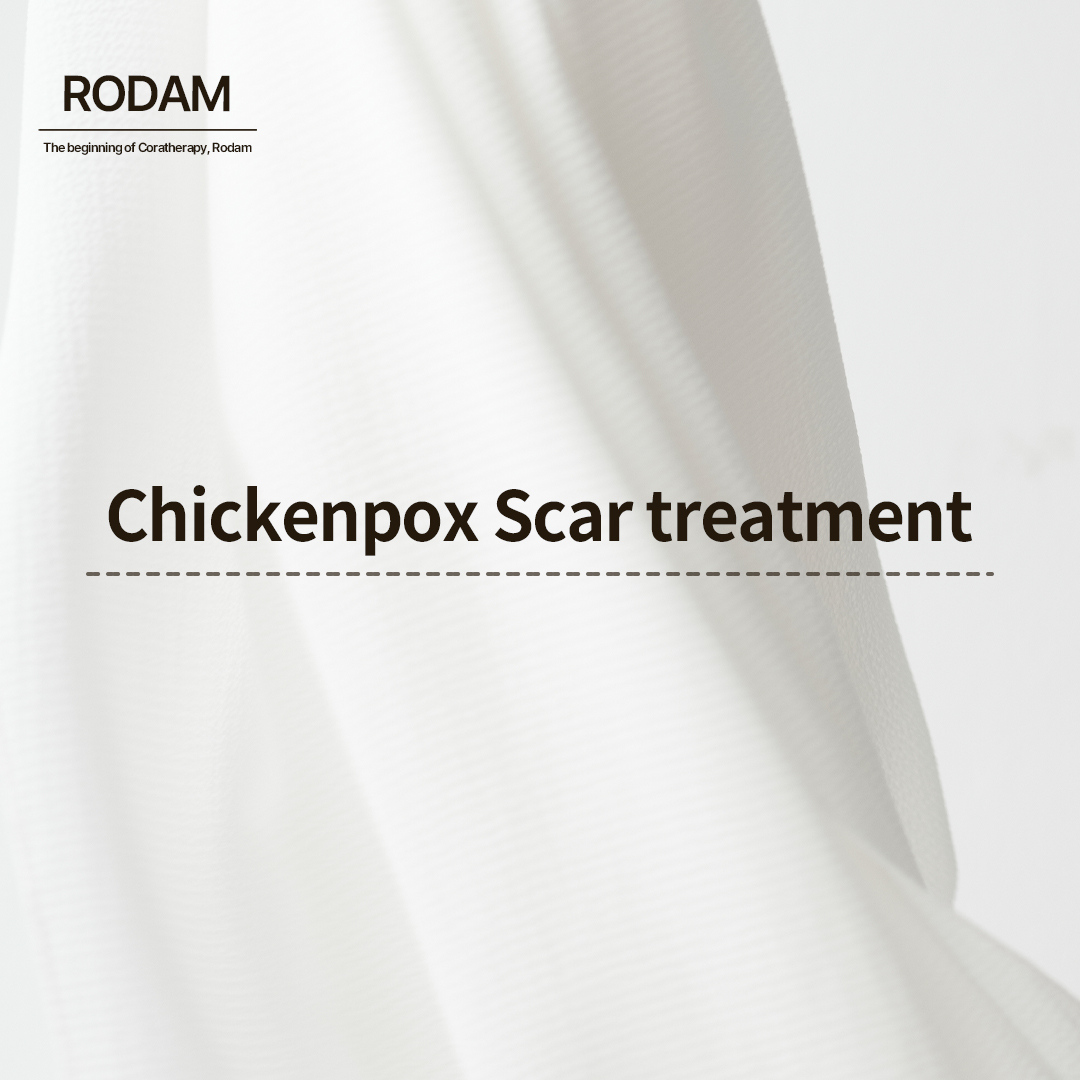
Causes and Characteristics of Chickenpox, Treatment for Scarring, and Reviews of Coratherapy at Rodam Korean Medicine Clinic
Hello, this is Rodam Korean Medicine Clinic, the beginning of Coratherapy for scar removal.
In the past, chickenpox was a common viral disease that most people experienced during childhood.
However, not many people are fully aware of its causes, symptoms, and recovery process.
Additionally, thanks to vaccinations, the number of people suffering from chickenpox has significantly decreased.
That said, it does not mean that the incidence of chickenpox has completely disappeared.
There are still many people struggling with chickenpox,
and even after the symptoms subside, many are left with concerns about scars.
Therefore, today we will explore the causes and main characteristics of chickenpox,
and introduce Coratherapy, a treatment method for depressed scars caused by chickenpox.

Causes and Characteristics of Chickenpox

First, chickenpox is caused by a virus.
Chickenpox is a highly contagious disease caused by the Varicella-Zoster Virus (VZV),
which spreads easily from person to person through airborne droplets or direct contact.
The risk of infection increases with physical contact or staying in close spaces with others, so caution is necessary.
However, since the chickenpox virus has an incubation period of about 10-21 days after exposure,
it is difficult to immediately determine whether one has been infected, and by the time symptoms appear, it may have already spread to others.
Chickenpox is more likely to occur in individuals with weakened immune systems.
In particular, children, whose immune systems are not yet fully developed, are the primary targets of infection.
That said, adults are not immune to infection.
In fact, adults tend to experience more severe symptoms compared to children,
so those who have not been vaccinated or have never had chickenpox should be especially cautious.
While chickenpox is a disease that mostly resolves naturally,
proper management is necessary to alleviate symptoms and prevent complications.
If a fever occurs, taking antipyretics to control body temperature is recommended,
and for severe itching, taking antihistamines can help alleviate symptoms.
Keeping fingernails short to avoid scratching the skin,
and taking light baths with lukewarm water for cleanliness, can also be beneficial.
Although these methods can help alleviate chickenpox symptoms,
if the blisters caused by chickenpox burst during care, they often leave scars.
Chickenpox scars are characterized by depressions or indentations in the skin that form as the skin heals rapidly.
Over time, the skin tissue hardens,
and the absence of pigmentation and pores makes the texture difference with the surrounding skin more pronounced.
One of the treatment methods for these depressed scars is
Coratherapy, a Korean Medicine scar treatment.
The effectiveness of Coratherapy can be seen in the following case.

Chickenpox Depressed Scar Coratherapy Treatment Review

Case :: 30-Year-Old Long-Standing Chickenpox Scar
History :: Tried various procedures but saw no results
Report :: Completed 6 sessions of Coratherapy
This patient had depressed scars on the corner of the mouth and chin area
due to chickenpox experienced during childhood.
The patient had been stressed about the scars for over 30 years
and tried various procedures but was not satisfied with the results.
Finally, they decided to try Coratherapy.
Despite concerns that Coratherapy might also be ineffective due to the lack of results from previous treatments,
we explained the principles of Coratherapy
and assured them that depressed scars like chickenpox scars could be effectively treated.
The treatment was planned with a goal of completing 6 sessions of Coratherapy.
Before the first session, the scarred areas were visibly depressed, with a clear height difference from the surrounding skin.
However, after the second session, improvements in the scarred areas began to be noticeable.
Although the scars appeared darker due to redness following the treatment,
photos taken after the second session already showed that the boundaries between the scars and the surrounding skin were diminishing.

By the end of the 6 sessions, the scars had almost disappeared,
and the patient expressed satisfaction with the results.
This demonstrates that even long-standing chickenpox depressed scars can be effectively treated with Coratherapy.
The effectiveness of Coratherapy lies in its treatment principles.
Rodam Korean Medicine Clinic’s Coratherapy, which began in 2006, is a treatment method for depressed scars
that activates the skin’s natural regenerative ability to promote the growth of new skin.
Rodam Korean Medicine Clinic’s Coratherapy uses specially designed needles during the procedure,
allowing for more precise stimulation of the boundary between the scar and normal skin.
This makes it possible to treat depressed scars more effectively and naturally.
If you are still struggling with depressed scars,
please feel free to visit Rodam Korean Medicine Clinic.
With years of accumulated expertise and a team of doctors dedicated to scar treatment,
we are always here to help you.
We hope today’s post has helped alleviate some of your concerns.
If you have any further questions, please do not hesitate to contact us. Thank you.

